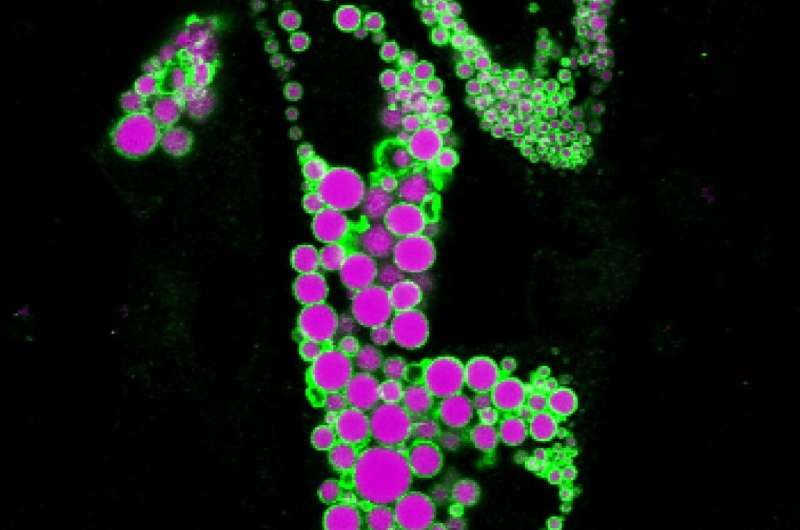This article has been reviewed according to Science X's editorial process and policies. Editors have highlighted the following attributes while ensuring the content's credibility:
fact-checked
peer-reviewed publication
trusted source
proofread
Scientists reveal adipocytes' metabolic role and identify treatment targets

Recent research underscores the critical role of adipocytes in storing fat, vital for organismal survival. Dysfunctional adipocytes can lead to metabolic disorders like type 2 diabetes and fatty liver disease, highlighting the importance of understanding lipid storage mechanisms.
A team of scientists led by Helmholtz Munich have developed a novel approach merging proteomics with machine learning to map dynamic changes during adipogenesis. This method reveals new insights into protein regulation, offering potential targets for managing metabolic diseases. The work has been published in Nature Metabolism.
Unlocking the secrets of fat storage
Living organisms have evolved the remarkable ability to store energy in the form of fat, a vital adaptation crucial for survival. In periods of energy abundance, this fat is stored within specialized cells called adipocytes, ensuring a reserve for times of scarcity.
Unlike many other cell types that struggle with lipid management and can suffer from lipid toxicity, adipocytes excel in storing significant amounts of fat. On average, a healthy adult carries between 10 to 25 kilograms of fat, primarily housed in adipose tissue, with each kilogram harboring roughly 9,000 kilocalories of energy.
However, when adipocytes malfunction, it can lead to metabolic disorders. Inefficient fat storage by adipocytes results in fat accumulation in other bodily regions, contributing to conditions such as type 2 diabetes and fatty liver disease. Therefore, comprehending the intricate cellular mechanisms governing lipid storage in adipocytes is imperative.
Such understanding opens avenues for identifying novel pharmacological targets to regulate adipocyte function. Ultimately, this knowledge holds promise for developing innovative treatments aimed at managing and preventing metabolic disorders associated with adipocyte dysfunction.
Mapping cellular changes in adipogenesis
Adipocytes emerge from precursor cells nestled within adipose tissue through a process called adipogenesis. Yet the intricacies of this transformation, particularly how cells restructure themselves to optimize lipid storage capabilities, have long puzzled researchers.
Pioneering a novel approach, scientists from Helmholtz Munich, the Karolinska Institute in Stockholm, and the German Center for Diabetes Research (DZD) have merged proteomics with machine learning to construct time-resolved cellular maps of adipogenesis.
Through this innovative method, researchers can capture snapshots of cellular dynamics, providing unprecedented insights into the remodeling of cellular compartments and, for the first time, tracking the dynamic shifts in protein localization during this process.
"We've successfully mapped previously unseen alterations in cellular architecture within fat cells as they undergo specialization for fat storage. By capturing snapshots of these cells throughout their developmental stages using proteomic techniques, we've identified novel regulators involved in both fat storage and mobilization," explains Dr. Natalie Krahmer, the lead researcher of the study.
Key proteins with obesity treatment potential
Their discoveries have revealed that a remarkable 20% of all proteins change localization, emphasizing the critical role of protein placement in cell specialization. Through their method, they have unveiled the synchronized regulation of protein levels and localization, laying the groundwork for efficient lipid storage.
Moreover, the researcher identified novel regulators of lipid storage, exposing previously unknown proteins associated with lipid droplets—the vital structures facilitating lipid storage within cells.
Interestingly, the absence of one such protein prevents cells from mobilizing stored lipids, resulting in excessive lipid accumulation. Importantly, analysis of patient data has highlighted a correlation between reduced levels of this protein in adipose tissue and obesity.
This significant finding underscores the clinical relevance of the protein, suggesting its potential as a pivotal determinant of adipocyte capacity to mobilize stored fat and as a promising target for the development of obesity treatments.
More information: Klingelhuber, F., et al. A spatiotemporal proteomic map of human adipogenesis. Nature Metabolism (2024). DOI: 10.1038/s42255-024-01025-8





















